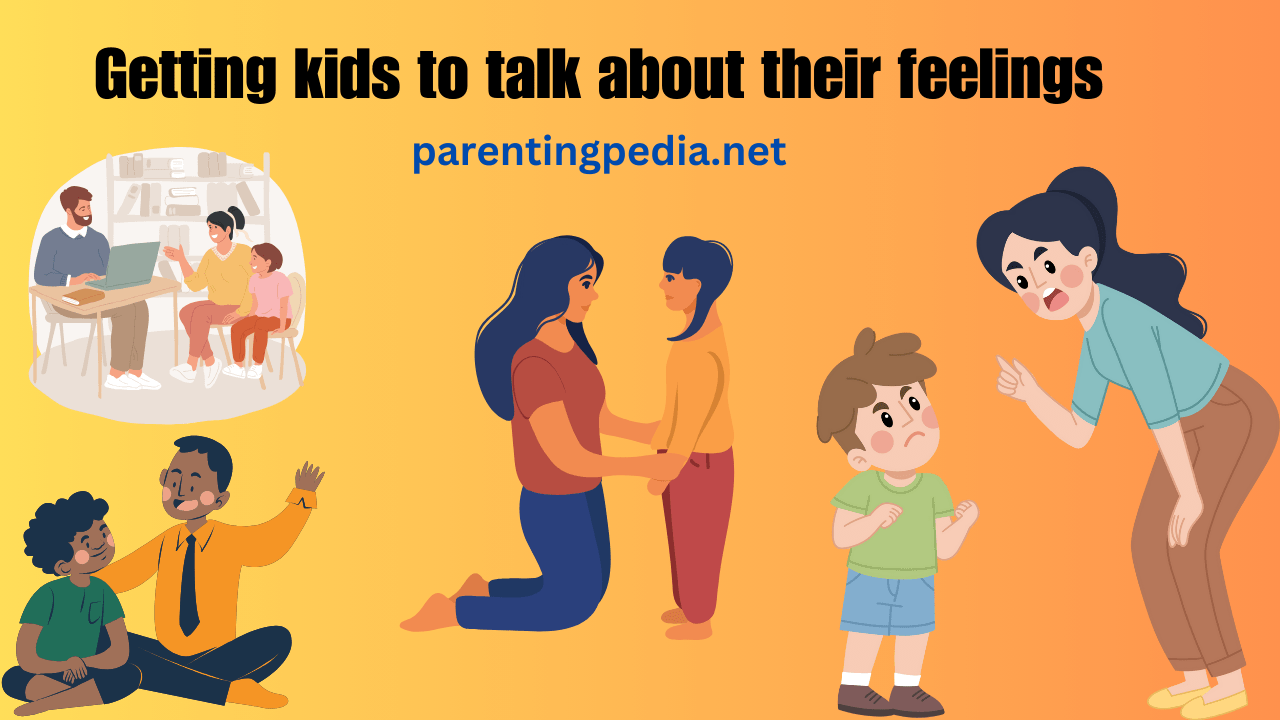You know your kid is upset, but getting them to open up and talk about their feelings can feel like pulling teeth. As parents, we want our children to feel comfortable coming to us when they’re struggling, but it’s a skill that takes time and practice to develop.
The good news is, that there are some effective strategies you can try to get your child talking about their feelings in a healthy way.
Whether they’re experiencing anxiety, sadness, anger, or any other feeling, helping them identify and express how they feel is one of the most important life skills you can teach them.
In this article, we’ll explore ways to create an open environment, ask the right questions, and set a good example to help get your kids talking about their feelings
Why It’s Important to Get Kids Talking About Their Feelings
Getting children to open up about their emotions is crucial for their well-being and development. When kids learn to identify and express how they feel, it helps them build healthy relationships and cope with challenges in a constructive way.
As a parent, creating an open environment where your child feels comfortable sharing their feelings should be a top priority. Make time to really listen without judgment when your child wants to talk. Respond with empathy, understanding, and care. This shows them that their feelings are valid and that you are there to provide support.
It’s also important to encourage your child to articulate their emotions through open-ended questions and conversations. For example, ask “How did that make you feel?” or “What emotions are you experiencing right now?” Help them build an emotional vocabulary by teaching words to describe feelings like frustrated, anxious, excited, or proud.
Kids often act out when they lack the skills to express their feelings in healthy ways. Emotional outbursts, moodiness, and behavioral issues can frequently be traced back to a child’s inability to recognize, verbalize, and manage their feelings.
Helping your child develop emotional intelligence at an early age will benefit them for life. By learning to navigate their inner world of feelings, they gain valuable tools to build self-confidence, resolve conflicts in constructive ways, and cultivate meaningful relationships. Isn’t that what every parent wants for their child?
Tips to Help Your Child Open Up and Express Emotions
To get your kids to open up about their feelings, try these tips:
Listen Without Judgment
The most important thing is to listen without criticism or judgment. Let your child know you care about their feelings and you’re there to support them. Provide empathy and reassurance.
- Make eye contact, give them your full attention, and maintain an open, compassionate attitude.
- Repeat what they say to show you understand. Say something like, “It sounds like you felt frustrated when that happened.”
- Ask open-ended questions to get them talking, like “How did that make you feel?” or “Do you want to talk about it?”
Create Opportunities for Conversation
Look for chances to start a dialog and check in on their emotional state. Some options:
- At dinner, ask each family member to share one thing that made them happy and one thing that was frustrating.
- When driving kids to activities, turn off electronics and chat. Say, “We haven’t talked in a while. How are you feeling lately?”
- If you notice behavioral changes, gently ask if anything is bothering them. Your concern can open the door to a helpful discussion.
Model Emotional Expression Yourself
Kids often mimic their parents’ behaviors. Model expressing your own feelings in a healthy, constructive way. Discuss coping strategies you use when you’re angry, anxious, or upset. Your transparency will make them more comfortable opening up to you in return.
With patience and practice, these techniques can help develop your child’s ability to identify and express their emotions. Keep at it – the benefits of emotional intelligence last a lifetime.
Creative Activities to Encourage Kids to Talk About Feelings
Creative activities are a great way to get kids talking about their feelings. Here are a few ideas to try:
Drawing or Doodling
Have your child draw or doodle anything that comes to mind. Then ask them to describe their creation. What emotions does it represent? How were they feeling when they made it? Drawing taps into a different part of the brain and can help kids open up in new ways.
Role Playing
Act out scenarios where different emotions are involved. For example, have your child pretend to be excited, scared or frustrated. Ask them how it feels to experience those emotions. Role-playing helps build empathy and gives kids practice articulating their feelings.
Keeping a Journal
Encourage your child to keep a private journal or diary to write down their thoughts and feelings. Let them know they can share as much or as little as they want. Journaling is a great outlet for emotions and can help clarify feelings that are hard to express out loud.
Creative Writing
Have your child write a short story, poem or song about different emotions. For example, ask them to write about a time they felt happy, sad or angry. Creative writing engages their imagination and gives them an indirect way to open up about their feelings.
Talking to a Pet or Stuffed Animal
It can be easier for kids to share emotions with someone who won’t judge them. Have your child talk to a pet, stuffed animal or imaginary friend. Let them know you’re there to listen without interrupting. Speaking freely to a non-judgemental listener helps kids work through complicated feelings.
Using creative techniques like these, you can get your child talking about their feelings in healthy ways. Be patient and give them opportunities to share at their own pace. With your support, kids can build emotional intelligence and learn to express themselves confidently.
How to Respond When Your Child Shares Difficult Emotions
When your child opens up about difficult emotions, it’s important to respond in a supportive and understanding way. Your reaction can have a big impact on their willingness to share sensitive feelings in the future.
Listen without judgment
Simply listen to your child and give them your full attention. Make eye contact, don’t look at your phone or other distractions. Hear them out without criticism or judgment. Say things like “I’m listening,” “Go on,” and “I want to understand.” Ask open-ended questions to make sure you grasp the full situation.
Acknowledge their feelings
Validate your child’s feelings by saying things like “I can understand why you feel that way.” Give them empathy and reassurance that their emotions are normal and okay. Say “It’s alright to feel sad/angry/frustrated.” Help them identify the emotions behind their distress. Putting words to feelings can help make them feel more manageable.
Offer comfort
Give your child emotional support through physical affection like hugs, holding hands, or a gentle touch on the arm. Your warmth and closeness can provide comfort. Ask if there’s anything you can do to help them feel better. Sometimes just talking about feelings can relieve distress, but they may also appreciate a fun distraction like watching a movie together or baking some cookies.
Follow-up and check-in
Continue the conversation over the next few days to show your child you care about how they’re feeling. Ask how they’re doing and if there’s any way you can offer more help or support. Let them know you’re there for them anytime they want to talk. Regular check-ins, even when emotions aren’t running high, help build your connection and make it more likely they’ll turn to you when upset.
With time and practice, sharing difficult emotions will get easier for your child. Your patience, understanding, and compassionate responses will give them the confidence to open up to you about anything. Make talking about feelings a normal part of your relationship and it can become second nature.
Teaching Kids Healthy Ways to Identify and Manage Complex Feelings
Teaching kids how to identify and manage complex emotions in a healthy way is a crucial life skill. As their feelings become more nuanced, it’s important to give them the tools to understand and express themselves.
Teach Them Emotional Vocabulary
Help your child build up their emotional vocabulary by discussing different feelings together. Make a list of emotions they may experience, like frustration, anxiety, excitement, or pride. Explain what each feeling means and that it’s okay to feel them. The more words they know to identify their feelings, the better they’ll get at expressing themselves.
Encourage Them to Talk About Their Feelings
Start conversations about emotions and share your own feelings to show them it’s normal to discuss them. Ask open-ended questions like “How did that make you feel?” or “What was that experience like for you?” Make eye contact, give them your full attention, and listen without judgment. The more you talk about feelings, the more comfortable they’ll feel opening up.
Help Them Identify Emotional Triggers
Work with your child to determine what events or situations trigger certain feelings. If they feel upset at school, discuss what specifically makes them feel that way. Once they identify the trigger, problem-solve ways to cope with it. This awareness and ability to manage emotional triggers will help reduce feelings of being overwhelmed by their emotions.
Teach Healthy Ways to Cope
When emotions start to feel big or uncontrollable, teach your child coping strategies to help them calm down and gain perspective. Deep breathing, taking a walk, journaling feelings, or talking to someone are all great options. Help them find what works for them so they have the skills to self-soothe during emotional moments.
With your support and guidance, kids can build emotional intelligence and learn to navigate their feelings in a healthy way. Keep the conversations going and encourage them to express themselves – it will benefit them for life.
Conclusion
So there you have it, some easy tips and strategies to get your kids to open up about their feelings. The key is to start these conversations early by modeling the behavior you want to see. Share how you feel, ask open-ended questions, and really listen without judgment when they do share. Make communicating about emotions a normal part of your everyday interactions. Give your kids the vocabulary and permission to express themselves in a healthy way. Helping children understand and manage their emotions at a young age will set them up for success in life and relationships. Keep at it – they’ll get there, and you’ll build closer bonds along the way.
Remember, the greatest reward of parenting lies in watching
your children soar with love and confidence.
Till then keep smiling and be happy 😊
Worth Reading 👇

